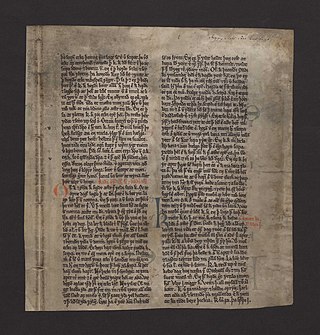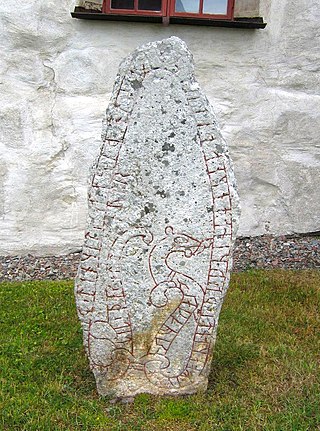
Heimskringla is the best known of the Old Norse kings' sagas. It was written in Old Norse in Iceland by the poet and historian Snorri Sturluson (1178/79–1241) c. 1230. The name Heimskringla was first used in the 17th century, derived from the first two words of one of the manuscripts.

Sweyn Forkbeard was King of Denmark from 986 until his death, King of England for five weeks from December 1013 until his death, and King of Norway from 999/1000 until 1013/14. He was the father of King Harald II of Denmark, King Cnut the Great, and Queen Estrid Svendsdatter.

Olaf Tryggvason was King of Norway from 995 to 1000. He was the son of Tryggvi Olafsson, king of Viken, and, according to later sagas, the great-grandson of Harald Fairhair, first King of Norway. He is numbered as Olaf I.

Olof Skötkonung, sometimes stylized as Olaf the Swede, was King of Sweden, son of Eric the Victorious and, according to Icelandic sources, Sigrid the Haughty. He succeeded his father in c. 995. He stands at the threshold of recorded history, since he is the first Swedish ruler about whom there is substantial knowledge. He is regarded as the first king known to have ruled both the Swedes and the Geats. In Sweden, the reign of king Olov Skötkonung is considered to be the transition from the Viking age to the Middle Ages, because he was the first Christian king of the Swedes, who were the last to adopt Christianity in Scandinavia. He is associated with a growing influence of the church in what is today southwestern and central Sweden. Norse beliefs persisted in parts of Sweden until the 12th century.

The Battle of Svolder was a large naval battle during the Viking age, fought in September 999 or 1000 in the western Baltic Sea between King Olaf of Norway and an alliance of the Kings of Denmark and Sweden and Olaf's enemies in Norway. The backdrop of the battle was the unification of Norway into a single independent state after longstanding Danish efforts to control the country, combined with the spread of Christianity in Scandinavia.

Sigrid the Haughty, also known as Sigrid Storråda (Swedish), is a Scandinavian queen appearing in Norse sagas. Sigrid is named in several late and sometimes contradictory Icelandic sagas composed generations after the events they describe, but there is no reliable historical evidence correlating to her story as they describe her. She is reported by Heimskringla to have been wife of Eric the Victorious of Sweden, sought as wife by Olaf Tryggvasson, then married to Sweyn Forkbeard of Denmark, but elsewhere author Snorri Sturluson says that Sweyn was married to a different woman.
Haakon Sigurdsson, known as Haakon Jarl, was the de facto ruler of Norway from about 975 to 995. Sometimes he is styled as Haakon the Powerful, though the Ágrip and Historia Norwegiæ give the less flattering name Hákon Illi, that is, Haakon the Bad.

Thorkell the Tall, also known as Thorkell the High in the Anglo-Saxon Chronicle, was a prominent member of the Jomsviking order and a notable lord. He was a son of the Scanian chieftain Strut-Harald, and a brother of Jarl Sigvaldi, Hemingr and Tófa. Thorkell was the chief commander of the Jomsvikings and the legendary stronghold Jomsborg, on the Island of Wollin. He is also credited as having received the young Cnut the Great into his care and taken Cnut on raids. The Encomium Emmae, a document aimed at the movers and shakers of the Anglo-Scandinavian court in the early 1040s, describes Thorkell as a great war leader and warrior.
Erik Hakonsson, also known as Eric of Hlathir or Eric of Norway, was Earl of Lade, Governor of Norway and Earl of Northumbria. He was the son of Earl Hákon Sigurðarson and brother of the legendary Aud Haakonsdottir of Lade. He participated in the Battle of Hjörungavágr, the Battle of Svolder and the conquest of England by King Canute the Great.

The Jomsvikings were purportedly a legendary order of Viking mercenaries or conquerors of the 10th and 11th centuries. Though reputed to be staunchly dedicated to the worship of the Old Norse gods, they would allegedly fight for any lord who could pay their substantial fees, even if they may be Christian. The institution of the Jomsvikings would itself foreshadow those of the later religious and chivalric orders of the Middle Ages.

The Jómsvíkinga saga is a medieval Icelandic saga composed by an anonymous author. The saga was composed in Iceland during the 13th century. It exists in several manuscripts which vary from each other. There are many different versions and translations of the saga.

Ulf Thorgilsson, commonly known as Ulf Jarl, was a Danish jarl of Skåne and regent of Denmark. Ulf was the son of Thorgil Sprakling and the father of King Sweyn II of Denmark and thus the progenitor of the House of Estridsen, which would rule Denmark from 1047 to 1375, which was also sometimes, specially in Swedish sources, referred to as the Ulfinger dynasty to honor him.

Vagn Åkesson was a Norseman of the late 10th century, mentioned in the Jómsvíkinga saga. At the age of 12, Vagn, a warrior, applied for admission to the mercenary brotherhood of the Jomsvikings. According to the Jómsvíkinga saga, Vagn was the son of Aki, a son of the Jomsviking chieftain Palnatoke. Intrigued by the courage displayed by Vagn, his grandfather Palnatoke allowed him to prove his worth with a duel against Sigvaldi Strut-Haraldsson, whom Vagn defeated. He was admitted to the order despite the Jomsviking rule that no man under the age of 18 be allowed to join.

Einar Eindridesson Thambarskelfir was an influential Norwegian noble and politician during the 11th century. He headed the feudal lords in their opposition to Olaf Haraldsson.

The Battle of Hjörungavágr is a semi-legendary naval battle that took place in the late 10th century between the Jarls of Lade and a Danish invasion fleet led by the fabled Jomsvikings. This battle played an important role in the struggle by Haakon Sigurdsson to unite his rule over Norway. Traditionally, the battle has been set during the year 986, though the Gesta Wulinensis ecclesiae pontificum has the year 984 as the year of the battle.

Finnr Árnason was a Norwegian nobleman and advisor to both King Olaf Haraldsson and King Harald III of Norway and later served King Sweyn II of Denmark. He was the feudal lord (lendmann) of Austrått.
Strut-Harald was a semi-legendary jarl or petty king who ruled over the Danish territory of Scania during the late 10th century CE. Some of the Norse sagas identify him as the son of Gorm the Old, making him a brother or half-brother of Harald Bluetooth.

Gunnhildr konungamóðir or Gunnhildr Gormsdóttir, whose name is often Anglicised as Gunnhild is a quasi-historical figure who appears in the Icelandic Sagas, according to which she was the wife of Eric Bloodaxe. She appears prominently in sagas such as Fagrskinna, Egils saga, Njáls saga, and Heimskringla.

Tryggvi "the Pretender" was a Viking chieftain who lived in the early eleventh century, and came from "west across the sea". His story appears in Heimskringla by Snorri Sturluson, the saga Morkinskinna, and a saga composed by Oddr Snorrason on Olaf Tryggvason.

Tyra of Denmark was a 10th-century Danish princess. She was the spouse of both King Olav I of Norway and of Styrbjörn Starke, prince of Sweden.
















